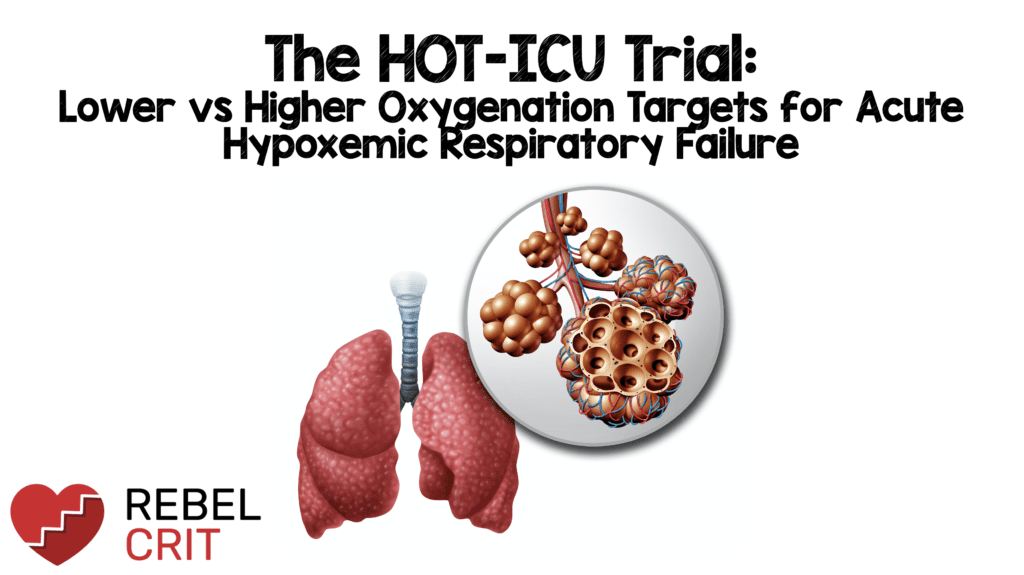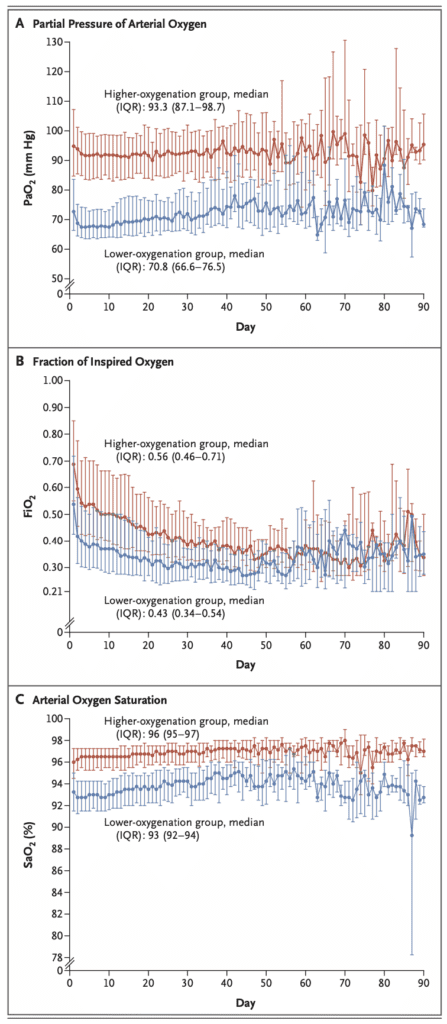
 Background: Though oxygen is fundamental for life, supra-physiological levels can be deleterious. Several randomized controlled trials and meta-analyses have been conducted in the critically ill to determine whether a conservative oxygenation approach compared to a liberal oxygenation approach is beneficial. The OXYGEN-ICU trial was one of the first trials to explore this issue in 2016. It was a small, single centered trial with 434 ICU patients that showed a significantly lower ICU mortality in the conservative oxygenation group with an ARR 8.6%1. ICU-ROX (Mechanically ventilated patients) and LOCO2 (ARDS patients) were two more randomized trials that explored critically ill patients in the ICU with conflicting evidence on oxygen targets. There was no mortality benefit or ventilator free days in either study2,3. Although in the LOCO2 trial there was a clinically relevant excess mortality in the conservative group of 14 percentage points higher than in the liberal group at 90 days (not statistically significant) Additionally, the LOCO2 trial found a higher rate of intestinal ischemia in patients with a conservative oxygenation strategy3. Based on these three trials it can be stated that both hyperoxia (SpO2 >97%) and hypoxemia (SpO2 <90%) should be avoided. An SpO2 of 92 to 96% (PaO2 60 to 90) would be the ideal target in these patients. Until now, there has not been any good data regarding oxygenation parameters in patients with acute hypoxemic respiratory failure.
Background: Though oxygen is fundamental for life, supra-physiological levels can be deleterious. Several randomized controlled trials and meta-analyses have been conducted in the critically ill to determine whether a conservative oxygenation approach compared to a liberal oxygenation approach is beneficial. The OXYGEN-ICU trial was one of the first trials to explore this issue in 2016. It was a small, single centered trial with 434 ICU patients that showed a significantly lower ICU mortality in the conservative oxygenation group with an ARR 8.6%1. ICU-ROX (Mechanically ventilated patients) and LOCO2 (ARDS patients) were two more randomized trials that explored critically ill patients in the ICU with conflicting evidence on oxygen targets. There was no mortality benefit or ventilator free days in either study2,3. Although in the LOCO2 trial there was a clinically relevant excess mortality in the conservative group of 14 percentage points higher than in the liberal group at 90 days (not statistically significant) Additionally, the LOCO2 trial found a higher rate of intestinal ischemia in patients with a conservative oxygenation strategy3. Based on these three trials it can be stated that both hyperoxia (SpO2 >97%) and hypoxemia (SpO2 <90%) should be avoided. An SpO2 of 92 to 96% (PaO2 60 to 90) would be the ideal target in these patients. Until now, there has not been any good data regarding oxygenation parameters in patients with acute hypoxemic respiratory failure.
Article: Schjorring O et al. Lower or Higher Oxygenation Targets for Acute Hypoxemic Respiratory Failure. NEJM. Jan 2021. PMID 33471452 [Access on Read by QxMD]
Clinical Question: Does lower oxygenation with PaO2 60 mmHg reduce 90-day mortality compared to higher oxygenation with PaO2 90 mmHg in patients admitted to ICU with acute hypoxemic respiratory failure?
Design:
- Handling Oxygenation Targets in the ICU (HOT-ICU)
- Investigator-initiated, multicentered, randomized controlled trial across 35 European ICUs from June 2017 – August 2020
- 1:1 randomization of 2928 patients to receive oxygen therapy with either:
- Low O2: PaO2 60 mmHg
- High O2: PaO2 90 mmHg
- Oxygenation targets were achieved by adjusting FiO2
- Deviations from target of more than 7.5 mmHg were only accepted in patients with an FiO2 21% or patient with FiO2 100%
Outcome:
- Primary Outcome: All-cause mortality at 90d
-
Secondary Outcomes:
- Number of patients with one of more serious adverse events
- New shock
- Myocardial ischemia
- Cerebral ischemia
- Interstitial ischemia
- Percentage of days that patients were alive without life support (mechanical ventilator, renal replacement therapy, vasopressors)
- Percentage of days that patients were alive after hospital discharge
- Number of patients with one of more serious adverse events
Inclusion Criteria:
- Adults age >18 admitted to ICU with hypoxemic respiratory failure
- Within 12 hours of admission to the ICU
- Require at least 10L/min O2 via facemask or at least 50% FiO2 via invasive or noninvasive ventilation
- Arterial line monitoring in place
- Expected to be admitted in the ICU for at least 24 hours
Exclusion Criteria:
- Unable to undergo randomization within 12 hours after ICU admission
- Receive home oxygen or chronic mechanical ventilation
- Brain death deemed inevitable
- Receive hyperbaric oxygen treatment
- Underwent solid-organ transplantation during hospital admission
- Poisoned with carbon monoxide poisoning, cyanide, or paraquat, methemoglobinemia
- Sickle cell disease
- Previously treated with bleomycin
Key Results:
- Enrolled 2928 patients across 35 ICUs in 7 countries
- Lower oxygenation group: N = 1441 (excluded at 90-day follow-up: 21)
- Higher oxygenation group: N = 1447 (excluded at 90-day follow-up: 19)
- Mean age: 70 years (range 60-77)
- Type of admission: medical (85.9% vs 85.1%)
- Acute illness: pneumonia (57.7% vs 57.4%); ARDS (12.3% vs 13.4%)
Median PaO2
- Low O2: 70.8 mm Hg (range 66.6 – 76.5)
- High O2: 93.3 mm Hg (range 87.1 – 98.7)
Median Oxygen Saturation
- Low O2: 93% (range 92-94)
- High O2: 96% (range 95-97)
90-day Mortality
- Low O2: 42.9%
- High O2: 42.4%
- RR: 1.02 (95% CI 0.94 to 1.11; p = 0.64)
- No statistical difference
Median % Days Alive Without Life Support
- Low O2: 87.8% (range 0.0 – 96.7)
- High O2: 84.4% (range 0.0 – 96.0)
- P = 0.10
- No statistical difference
Median % Days Alive After Hospital Discharge
- Low O2: 55.6% (range 0.0 – 85.6)
- High O2: 50.0% (range 0.0 – 84.4)
- P = 0.67
- No statistical difference
Adverse Events: no difference between two groups
Strengths:
- International trial with a variety of ICUs in different countries
- Were able to show a clear between group difference in PaO2, SaO2, and FiO2 levels
- Addresses a clinically important question
- Intention-to-treat analysis which is more likely to reproduce real world practice
- Follow up excellent with data available for 98.2% of patients enrolled
- Groups were well balanced at baseline with the exception of cardiac arrest (Low O2 10.3% vs High O2 12.8%)
- The use of mechanical ventilation, prone positioning, inhaled vasodilators, ECMO, circulatory support, RRT, and blood transfusions were similar between groups
Limitations:
- 700 patients excluded because they were unable to undergo randomization within 12 hours of ICU admission suggesting convenience bias in enrollment
- Clinicians were aware of ongoing trial (non-blinded) which may allow them to make decisions regarding management that can affect outcome
- Baseline patient population was admitted to medical ICU, elderly, and with very high mortality – limiting generalizability
- PaO2 sampling was not protocolized, leading to variable FiO2 titration
- Lower oxygenation group did not consistently reach target PaO2 60 mm Hg which reduced separation, and could have possibly affected the primary outcome
- Unable to detect differences in subgroups as the groups are too small
Discussion:
- Study was powered to look for a between group difference of 5% in mortality at 90d after randomization with the assumption of a 25% mortality in the higher oxygenation group based on previous data
- This trial showed no difference in 90-day mortality in the lower oxygenation target compared to higher oxygenation target in critically ill patients with acute hypoxemic respiratory failure. The results of this trial are not all that surprising as the two groups were essentially very similar. The low oxygen target group had a mean 02 saturation of 93% compared to 96% in the higher oxygen target group. There was a difference in the mean pa02 in both groups, 70.8 vs 93.3, however clinically this is not a major difference, as both are on the flat upper portion of the oxygen dissociation curve.
- Odds ratio of death from any cause at 90 days ranges from (-2.92 to 4.17), suggesting it “does not preclude the possibility of clinically important harm or benefit in the lower oxygenation population.”
- No differences in primary outcome in sub-group analyses
- Clear separation between oxygen target groups, but the low O2 group seemed to be 10mmHg higher than the 60mmHg which was the target

Author’s Conclusion: “Among adult patients with acute hypoxemic respiratory failure in the ICU, a lower oxygenation target did not result in lower mortality than a higher target at 90 days.”
Clinical Take Home Point: This study adds very little new information into clinical practice and does not provide a definite answer for specific oxygenation parameters. Current evidence shows we should embrace lower PaO2 and SaO2 and continue to wean FiO2 as quickly and safely as possible while ensuring to not expose patients with suboptimal oxygen saturations. While we await the results of larger trials like MEGA-ROX, targeting an SpO2 of 92 to 96% (PaO2 60 to 90) is the ideal target.
Guest Post By:

Jinal Sheth, MD
Emergency Medicine Physician and Critical Care Fellow
Medstar Washington Hospital Center
Washington, DC
Twitter: @JShethMD
References
- Girardias, M. et al. Effect of Conversative vs. Conventional Oxygen Therapy on Mortality in an Intensive Care Unit. JAM 2016. PMID: 27706466
- ICU-ROX investigators et al. Conservative Oxygen Therapy during Mechanical Ventilation in the ICU. NEJM 2020. PMID: 31613432
- Barrot, L. et al. Liberal or Conservative Oxygen Therapy for Acute Respiratory Distress Syndrome. NEJM. 2020. PMID: 32160661
- Schjorring, O. et al. Lower or Higher Oxygenation Targets for Acute Hypoxemic Respiratory Failure. NEJM. Jan 2021. PMID 33471452 [Access on Read by QxMD]
For More Thoughts on This Checkout:
- St. Emlyn’s Blog: Oxygen Targets in Critical Care – The HOT-ICU Trial
- REBEL EM: ICU-ROX – Conservative vs Usual O2 Therapy During Mechanical Ventilation in the ICU
- REBEL EM: The LOCO2 Trial – Liberal or Conservative Oxygen Therapy for ARDS
- REBEL Cast: February 2017 REBEL Cast – The All Hyperoxia Edition
- The Bottom Line: HOT-ICU
Post Peer Reviewed By: Frank Lodeserto, MD (Twitter: @FrankLodeserto) and Salim R. Rezaie, MD (Twitter: @srrezaie)
The post The HOT-ICU Trial: Lower vs Higher Oxygenation Targets for Acute Hypoxemic Respiratory Failure appeared first on REBEL EM - Emergency Medicine Blog.
